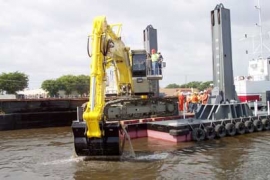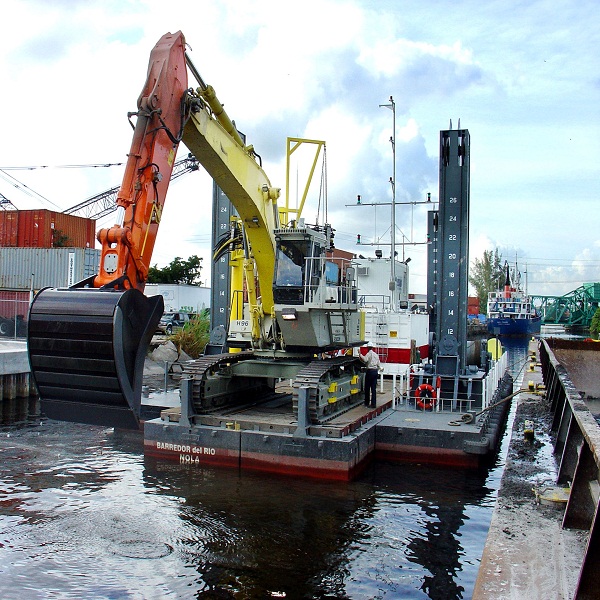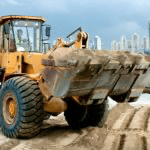Environmental dredging equipment is specially designed or adapted to remediate waterways that contain contaminated sediments.

Backhoe Dredger
WORK METHOD OF ENVIRONMENTAL EQUIPMENT
The work method of each environmental dredger is specific to the equipment. However, the key components to be evaluated when considering dredging for a clean-up operation include:
- sediment removal,
- transport,
- staging,
- treatment including pretreatment, treatment of water and sediment, if necessary, and
- disposal of both liquids and solids.
Environmental dredging is conducted in a way to minimise the spread of contaminants to the surrounding waters during the operation.
ADVANTAGES
During environmental dredging projects, turbidity presents an extreme challenge.
To protect surrounding waters and confine the spread of contamination, environmental dredging techniques aim to achieve a high concentration of dredged sediment with the lowest possible turbidity. The equipment is designed to optimise the precision with which operations are done.
Environmental dredging equipment is also built to remove accurate thin layers so that the least possible quantities of material are dredged. This means that less material requires treatment and disposal, which is a plus point since secure disposal of contaminated material is often a challenge.
DEDICATED EQUIPMENT
Dedicated equipment, which can dredge in a way that recognises the added hazard of working with contaminated sediments, is an important addition in the arsenal of dredging for sustainability.
Special “environmental dredgers” are often modifications of cutter suction hoppers, backhoes and grabs, in which the dredged materials are brought via a closed system to a barge or to disposal area. These modifications include:
- encapsulated bucket lines for bucket chain dredgers,
- closed buckets for backhoes,
- closed clamshells for grab dredgers, auger dredgers,
- disc cutters,
- scoop dredgers and
- sweep dredgers.
All of these are modifications of standard cutter dredgers. These dredgers also contain sophisticated automation and the ability to maximise the concentration of the sediments – which means controlling the excavation level as well as the layer thickness.
OTHER AUXILIARY ENVIRONMENTAL EQUIPMENT
Other auxiliary environmental equipment includes silt screens and/or air bubble screens. These screens enclose the area being dredged and prevent sediment from drifting into the general water body. The turbidity is then limited to the area being dredged and disturbance of the aquatic environment is kept to a minimum. The removal of the silt or bubble screen once the operation is completed requires careful attention.
TYPES OF MATERIAL
Environmental dredging is executed for the specific purpose of removing hazardous wastes that are detrimental to ecosystems, human and marine life.
Barge
LIMITATIONS
The very specific nature of a remediation project means that this equipment is not suited to high production rates. Also its highly specialised functions are not a low-cost investment. The cost of such clean-ups may make them difficult to implement in certain circumstances even though the long-term advantage is increased sustainability.
PRODUCTION RATES
The production level of these dredgers is often lower than with a normal dredging process because the goal is to work with high accuracy and minimise turbidity.
On the other hand, although sustained production rates for environmental dredgers are low, their precision allows the removal of contaminated sediments without removing clean material and this precision is ultimately cost-efficient.
PROJECT APPLICATIONS
Environmental dredging projects are generally smaller in scale than navigational or capital dredging, but because of their long-lasting environmental implications, environmental dredging projects are of special importance.
A capital dredging project may have an environmental component, but more often environmental dredging projects are specific initiatives designed to remove contaminated sediments with the goal of improving water quality and restoring the health of aquatic ecosystems.
Source: iadc-dredging












